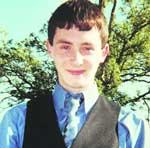Evidence in PSNI killing contradicts Ombudsman justification

The family of the first man killed by the PSNI say that the Police Ombudsman drew incorrect conclusions from the evidence on which police action was justified in the shooting. By Anton McCabe
The family of Neil McConville, the first man killed by the Police Service of Northern Ireland (PSNI), say that evidence exists which disproves the account of the killing given in a report by the former Police Ombudsman for Northern Ireland, Nuala O'Loan. According to the McConville family, the evidence contradicts O'Loan's conclusion that police action was justified in the shooting.
McConville, from Bleary, Co Down, was killed in April 2003 at Upper Ballinderry, Co Antrim, after police rammed his car and shot him. Photographic evidence of the scene obtained from the Ombudsman's office and the police indicate the car that McConville was driving when he was shot was pointing in the opposite direction to that claimed by police, and accepted by the Ombudsman.
According to the version of events in the Ombudsman's report, after police rammed McConville's car to stop it, McConville reversed at speed, spun the car round knocking down an officer, and then tried to put the car into gear. The report said: “The injured officer was directly in the vehicle's path. At least three of the officers present feared that, if the car drove forward, this officer would be killed or seriously injured and challenged the driver to stop, shouting that they were armed police. Mr McConville did not stop and continued to try to get away.” McConville was then shot three times from an MP5 submachine gun.
A police photo of the car at the scene shows a hedge on the passenger side. However, had the car been pointing in the direction police claimed, the photo would have shown a building site where a new house was being built on that side of the road.
Forensic scientist Gary Montgomery from the Ombudsman's office examined the scene “for any spent cartridge cases that may have been present”. “At the front nearside of the Cavalier, lying on the rough ground adjacent to the wheel, I found three spent 9mm.P calibre cartridge cases,” Montgomery said.
Spent rounds from an MP5 are ejected forward and to the right. If the car were facing in the direction police claimed, the cartridge cases would have been on the opposite side of the road.
In her report, the Ombudsman said a police officer was justified in shooting McConville because of fear another officer would be run over. She did, however, criticise police for attempting to deny her access to intelligence, for deleting a crucial intelligence file from a computer, and for poor management of the operation.
McConville's uncle, Barry McConville said, “[O'Loan's] report does not stand up to scrutiny and we will expose its inadequacies in court and at the inquest”. The McConville's are also concerned that O'Loan did not address the surveillance operation prior to the shooting. This was a major operation involving 21 police from the Headquarters Mobile Support Unit and a surveillance helicopter which began when the car left Craigavon on a return journey to Belfast. The McConvilles believe this level of surveillance was unwarranted against a 21-year old who had no paramilitary involvement.

(Pictured above: The McConville Family receive the report into Neil's killing at the Ombudsman's office)
The family also says the report failed to question police strategy. The Ombudsman reported that the PSNI had intelligence that the David ‘Dee' Somers, the passenger in the car, would be driving to Belfast to collect a gun. The report said that “Detective Superintendent BB placed considerable importance, in forming his strategic aims, on the need to remove the firearm from the streets”. However, it added: “The Detective Superintendent would also have been aware during this operation that other firearms still remained in the hands of known criminals whom (Somers) and Mr McConville had met, yet he had no strategy to try and recover those weapons and no such action was taken. This seems to be in conflict to his overall aim”. The report does not expand this point.
After the killing, police found an unloaded sawn-off shotgun concealed in McConville's car, but no ammunition. Somers was jailed for four years for possession of the weapon. In the book of evidence for Somers' trial, police officer U143 stated that, before the operation, he was told from whom Somers was collecting the weapon and where they were meeting. The man who supplied the weapon travelled to meet Somers in another car, then left without being followed. “lt was my understanding that the other suspect vehicle was not of interest to us,” U143 said.
Barry McConville said this raised serious concern. He asked why such an effort was made to recover one unloaded gun, but none to recover the store of weapons the supplier is supposed to have had. “Surely the police had the expertise to swoop at the collection point and scoop him and the guns? Why were Neil and Somers treated as such a threat, and a man with a store of guns wasn't?”
The McConville family have instructed solicitors to issue civil proceedings against the PSNI.
